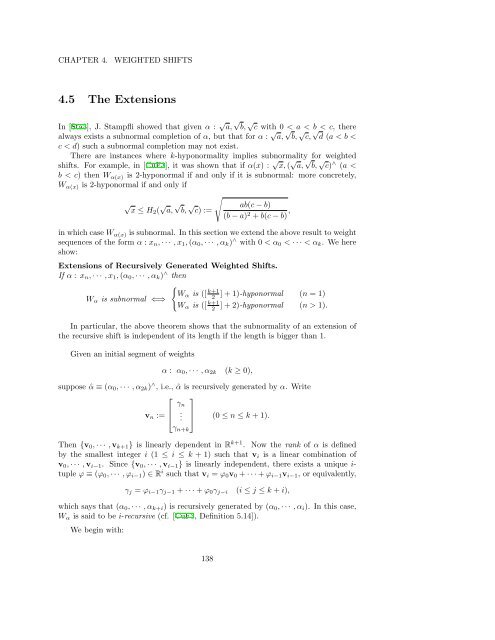Woo Young Lee Lecture Notes on Operator Theory
Woo Young Lee Lecture Notes on Operator Theory
Woo Young Lee Lecture Notes on Operator Theory
You also want an ePaper? Increase the reach of your titles
YUMPU automatically turns print PDFs into web optimized ePapers that Google loves.
CHAPTER 4.<br />
WEIGHTED SHIFTS<br />
4.5 The Extensi<strong>on</strong>s<br />
In [Sta3], J. Stampfli showed that given α : √ a, √ b, √ c with 0 < a < b < c, there<br />
always exists a subnormal completi<strong>on</strong> of α, but that for α : √ a, √ b, √ c, √ d (a < b <<br />
c < d) such a subnormal completi<strong>on</strong> may not exist.<br />
There are instances where k-hyp<strong>on</strong>ormality implies subnormality for weighted<br />
shifts. For example, in [CuF3], it was shown that if α(x) : √ x, ( √ a, √ b, √ c) ∧ (a <<br />
b < c) then W α(x) is 2-hyp<strong>on</strong>ormal if and <strong>on</strong>ly if it is subnormal: more c<strong>on</strong>cretely,<br />
W α(x) is 2-hyp<strong>on</strong>ormal if and <strong>on</strong>ly if<br />
√ x ≤ H2 ( √ a, √ √<br />
b, √ ab(c − b)<br />
c) :=<br />
(b − a) 2 + b(c − b) ,<br />
in which case W α(x) is subnormal. In this secti<strong>on</strong> we extend the above result to weight<br />
sequences of the form α : x n , · · · , x 1 , (α 0 , · · · , α k ) ∧ with 0 < α 0 < · · · < α k . We here<br />
show:<br />
Extensi<strong>on</strong>s of Recursively Generated Weighted Shifts.<br />
If α : x n , · · · , x 1 , (α 0 , · · · , α k ) ∧ then<br />
{<br />
W α is ([ k+1<br />
W α is subnormal ⇐⇒<br />
2<br />
] + 1)-hyp<strong>on</strong>ormal (n = 1)<br />
W α is ([ k+1<br />
2<br />
] + 2)-hyp<strong>on</strong>ormal (n > 1).<br />
In particular, the above theorem shows that the subnormality of an extensi<strong>on</strong> of<br />
the recursive shift is independent of its length if the length is bigger than 1.<br />
Given an initial segment of weights<br />
α : α 0 , · · · , α 2k (k ≥ 0),<br />
suppose ˆα ≡ (α 0 , · · · , α 2k ) ∧ , i.e., ˆα is recursively generated by α. Write<br />
⎡ ⎤<br />
γ ṇ<br />
⎢<br />
v n := ⎣ .<br />
⎥<br />
⎦ (0 ≤ n ≤ k + 1).<br />
γ n+k<br />
Then {v 0 , · · · , v k+1 } is linearly dependent in R k+1 . Now the rank of α is defined<br />
by the smallest integer i (1 ≤ i ≤ k + 1) such that v i is a linear combinati<strong>on</strong> of<br />
v 0 , · · · , v i−1 . Since {v 0 , · · · , v i−1 } is linearly independent, there exists a unique i-<br />
tuple φ ≡ (φ 0 , · · · , φ i−1 ) ∈ R i such that v i = φ 0 v 0 + · · · + φ i−1 v i−1 , or equivalently,<br />
γ j = φ i−1 γ j−1 + · · · + φ 0 γ j−i<br />
(i ≤ j ≤ k + i),<br />
which says that (α 0 , · · · , α k+i ) is recursively generated by (α 0 , · · · , α i ). In this case,<br />
W α is said to be i-recursive (cf. [CuF3, Definiti<strong>on</strong> 5.14]).<br />
We begin with:<br />
138













